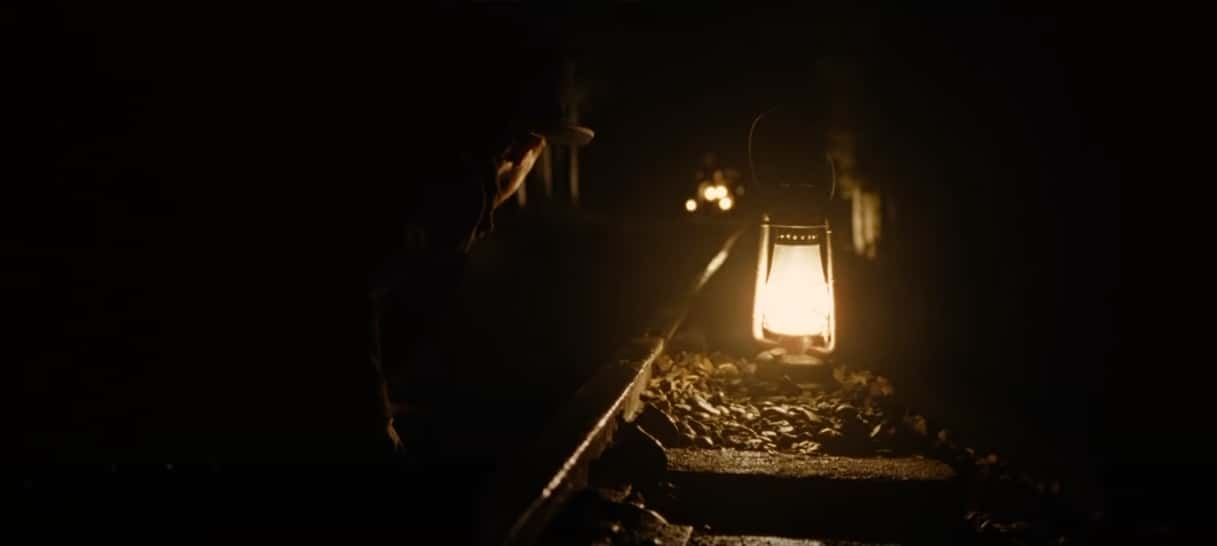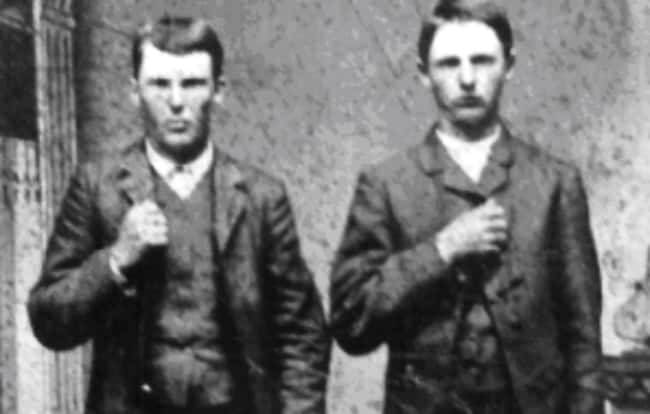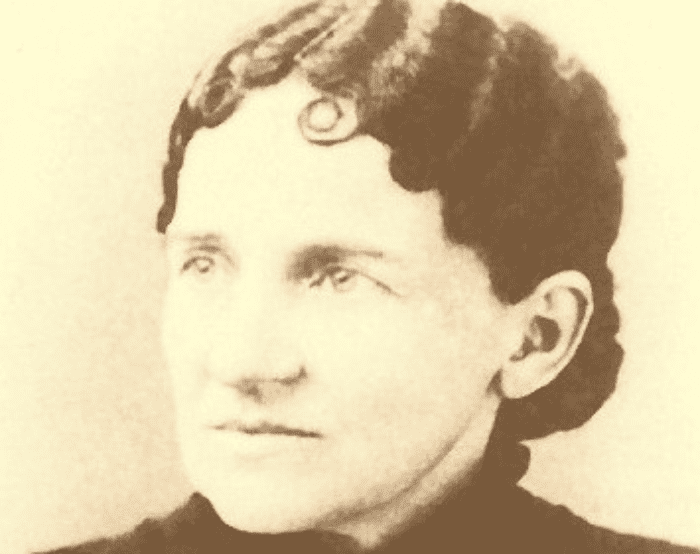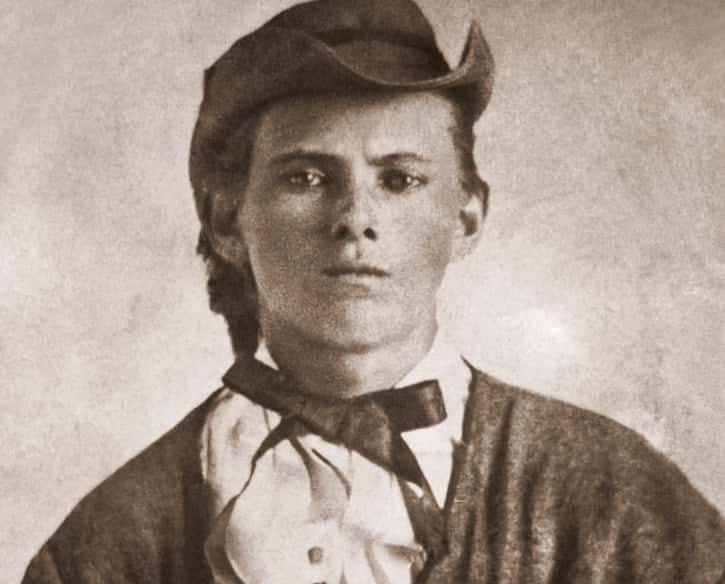In the long history of American outlaws, one name that always rings out is that of Jesse James. Immortalized in film and literature, James was already legendary by the time that his life was cut short by a coward. Like some of his contemporaries, James’s Wild West image has been glorified into a kind of Robin Hood myth. How true was it, though? Did his life live up to his legend? Read these facts and decide.
1. Your Birth Certificate, Please
James was born Jesse Woodson James on the 5th of September 1847, in Clay County, Missouri. He was the middle child in between his older brother, Frank, and his younger sister, Susan.

2. They’re Just Misunderstood!
The James-Younger Gang was one of the most well-known and most wanted illicit organizations of their day. They were said to have committed robberies in as many as 10 states, and its individual members were also wanted for other heinous offenses besides. Despite their brutality, though, they enjoyed a large amount of popular support in their day.
3. Son of a Preacher Man
James’s father was Robert James, a slave-owning hemp farmer. Robert was also a Baptist minister, and when James was a young child, Robert left his family for California to preach the word of God to gold searchers; he lost his life while there from cholera.
4. What a Woman!
When James’s father passed on in California, he left his family in serious financial trouble. James’s mother, Zerelda, re-married a wealthy man, but his clashes with her children–including Jesse–caused him to turn her kids out of his house. This naturally put a rift in the marriage, and Zerelda left her second husband. In 1855, she remarried again, moving her family to her new husband’s farm. She went on to have four children with her third husband.
5. Did Everyone Pay Their Membership Fees?
The James-Younger Gang’s origins lay in former Confederate bushwhackers going rogue in the wake of a Unionist victory. Its central members were Jesse and his brother, Frank, but the gang also included the four Younger brothers and other assorted associates.
 The long riders, 1980, Huka productions
The long riders, 1980, Huka productions
6. If It Bleeds, It Leads
One reason why James and his gang were branded as Wild West Robin Hoods was, in fact, the efforts of one man. John Newman Edwards was an editor who printed news articles favorable of James. He even wrote that James was worthy of Lancelot and King Arthur (admittedly, An American Outlaw in King Arthur’s Court would have made for an interesting spinoff). He also endorsed James as a Southern hero during an era where the South was still deeply bitter about how the Civil War had turned out.
7. I Love the Press
James wasn't one to miss the positive reviews of himself in the papers. He got a lot of fun out of handing out his own press releases to witnesses at the scenes of his transgressions. He didn’t even pretend to be unbiased in his amateur reporting, either!
 The Assassination of Jesse James, 2007,
The Assassination of Jesse James, 2007,
8. Named in Gratitude
James was, in fact, so grateful to John Newman Edwards for the free propaganda that when his son was born, he named him Jesse Edward James in honor of the editor!
 The Assassination of Jesse James, 2007, Warner Bros
The Assassination of Jesse James, 2007, Warner Bros
9. That’s My Boys!
While James and his brother, Frank, became known as notorious outlaws, they were always supported by their mother, Zerelda, who was known to be iron clad in her will and one tough cookie. Given all that she’d gone through to look after her kids, we’re not surprised in the slightest by that.
10. Like Father Like Son
James’s son, also named Jesse, went by the name "Tim" when he was young to avoid association with his famous outlaw father. Despite that, he ended up living under his father’s shadow in more ways than one. He was apprehended for a train theft in 1898 (though he was acquitted), and he would also go on to play his father in two films titled Jesse James Under the Black Flag and Jesse James as the Outlaw.
 The Assassination of Jesse James, 2007, Warner Bros
The Assassination of Jesse James, 2007, Warner Bros

History's most fascinating stories and darkest secrets, delivered to your inbox daily.
11. Hey Jesse, Ever Heard of Dr. Freud?
James had one spouse in his lifetime, and it was his first cousin. In a strange twist, his wife actually shared the same name as her aunt, James’s mother, Zerelda. It was just a different time…
 Wikipedia
Wikipedia
12. You Ain’t No Robin Hood
Contrary to his popularized image as an enemy of the rich and giver to the poor, there is no evidence that James or his gang ever gave away the money they took. Turns out he was just in it for the money and the thrill rather than some misguided humanitarian outlook.
 American outlaw, 2001, Morgan Creek
American outlaw, 2001, Morgan Creek
13. Oops!
James first gained notoriety when he robbed a bank in Gallatin in 1869. While he was in the process of doing so, James got the idea that a teller at the bank was former Union militiaman Samuel Cox. Since Cox had commanded the troopers that had slain his guerilla leader Bloody Bill Anderson, James was only too happy to take revenge and kill Cox in cold blood. The only problem? The teller wasn’t Cox at all. Red faces all around, eh, Jesse?
14. Meet Your Match!
In January 1874, a train at Gads Hill, Missouri was robbed by the James-Younger Gang, prompting authorities to call in the famous agency founded by Allan Pinkerton to hunt the outlaws down. Months later, however, things proved to be serious when multiple detectives working for the Pinkertons were slain while pursuing the gang.
 The Assassination of Jesse James, 2007, Warner Bros
The Assassination of Jesse James, 2007, Warner Bros
15. You Messed With the Wrong Man
The loss of detectives under his employ made things personal for Allan Pinkerton, and he found out how to hit James where it hurt most. Pinkerton raided the James family farm in January 1875, intending to burn it in revenge for his slain detectives. A combustible device thrown into the house exploded, taking the life of James’s younger half-brother and blowing off one of his mother’s arms.
 Wikipedia
Wikipedia
16. Striking Back
In response to the burning of his family’s home, James and his gang allegedly tracked down Daniel Askew, whom they suspected of aiding the Pinkertons in the attack, and took his life. But on a larger scale, the Pinkerton raid on the James family was widely unpopular and actually increased support for the outlaws. Former Confederates in power in Missouri actually limited the amount one could offer as a reward for the outlaws, which limited enthusiasm for hunting the outlaws down. While the two James brothers were exempt from this reward cap, it nevertheless did the trick.
 Frank & Jesse, 1994, Trimark Pictures
Frank & Jesse, 1994, Trimark Pictures
17. Heck of a Nickname
Before James’s name ever became printed on a Wanted poster, he earned himself the nickname "Dingus". While cleaning a pistol, he accidentally shot the tip of his finger off when the piece fired. Not fond of swearing, James reportedly exclaimed “That’s the dod-dingus pistol I ever saw!” We doubt that few people called him "Dingus" to his face, though.
18. What Was That Name Again?
During his lifetime, James famously had many aliases and fake names. Among them were Thomas Howard, John. D. Howard, William Campbell, and Charles Lawson. He was also known to fake a limp and walk with a cane to disguise his appearance.
19. Old Loyalties
The James-Younger Gang robbed Ste. Genevieve Savings Association in Ste. Genevieve, Missouri, on May 27, 1873. In an interesting twist, the gang left town firing their guns in the air while cheering “Hurray for Hildebrand!” This was in honor of the well-known Confederate bushwhacker named Samuel S. Hildebrand, who was originally from the area but had recently lost his life. Kind of a strange tribute to his memory, but these former Confederates must have seen some sense in it.
 Wikipedia
Wikipedia
20. Reunited at Last
James’s widow, Zerelda, perished on November 13, 1900, and was buried in the cemetery in Kearney, Missouri. A year and a half after her burial, James’s body was exhumed from where it was buried and laid to rest next to his wife.
21. Thanks, Will
Aside from Bloody Bill Anderson, Jesse and Frank James were both known to have ridden with the famous Confederate leader William Quantrill. Quantrill and his Raiders were infamous for their guerrilla tactics against Union forces. No doubt he taught the James brothers a lot about how to commit brutality and get away with it.
 Quantrill and His Raiders, 1958,
Quantrill and His Raiders, 1958,
22. Interesting Disguise
The James-Younger Gang’s first train heist occurred in July 1873 when they derailed a train on the Rock Island Line. Around $3,000 was stolen by the gang, which would have been worth $61,000 in 2017 U.S. currency. To avoid being recognized, the gang dressed up as members of the KKK, known enemies of Reconstruction.
 Getty Images
Getty Images
23. Crowning Achievement
One of the most successful robberies that the James-Younger Gang ever committed was when they robbed the Kansas Pacific Railroad near Muncie, Kansas, in 1874. They made off with a reported $30,000; in 2023, this amount would equal to just over $8000,000! Not sure why they didn’t just retire after a score like that!
24. Let’s Talk Business About This
After James’s demise and burial, his mother was said to have charged visitors a quarter to take a pebble from her son’s grave. To be fair, they would have probably taken such mementos anyway, might as well pay out royalties where they’re due.
 The Assassination of Jesse James, 2007, Warner Bros
The Assassination of Jesse James, 2007, Warner Bros
25. Tell Us How You Really Feel
For what it’s worth, James’s mother made sure that James’s epithet read as follows: “In Loving Memory of my Beloved Son, [Slain] by a Traitor and Coward Whose Name is not Worthy to Appear Here". At least she didn’t hold a grudge.
26. Well, That’s Bloodthirsty
In 1864, James and his brother Frank both fell under the command of Bloody Bill Anderson. Anderson was in charge of a company of bushwhackers known for their savagery towards those who fought for the Union army. James was later named as one of the men who took part in the Centralia Massacre. Despite being unarmed, a total of 22 Union fighters were slain or injured by the bushwhackers. The James family was actually forced to leave Clay County due to Jesse and Frank’s involvement in the brutal incident.
27. You Think That’s Violent? I’ll Show You Violent!
After the slaughter at Centralia, over 100 Union servicemen were sent after James, Bloody Bill Anderson, and the rest of the bushwhackers. Unfortunately for the Union troopers, they were all massacred by Anderson and his men. According to sources, the bushwhackers made sure to heavily mutilate their bodies to send a message.
28. It Could Have Gone Better…
The James-Younger Gang came to a bloody end in September 1876. They attempted to rob a bank at Northfield, Minnesota. However, the townspeople of Northfield fought back against the outlaws, grabbing guns from the local hardware store. Surprised, outgunned, and injured in the shootout, James and his brother Frank were the only ones who escaped capture. The rest of the James-Younger Gang was either eliminated or captured, ending their years of outlaw domination.
 Wikipedia
Wikipedia
29. Yay! We Drove Him Out of Town!
To this day, the town of Northfield, Minnesota has a festival celebrating the citizens’ defeat of the James-Younger Gang. Held every September during the weekend after Labor Day, it remains one of the biggest outdoor celebrations in all of Minnesota. Turns out not everyone is a fan of James!
 dinosauriens
dinosauriens
30. A Much-Credited Name
Dozens of actors have played James in films based on the outlaw’s escapades. The more well-known actors who have done so include Tyrone Power, Audie Murphy, Kris Kristofferson (who also played Billy the Kid in another film), Robert Duvall, Colin Farrell, and Brad Pitt.
 American Outlaw, 2001, Morgan Creek Entertaiment
American Outlaw, 2001, Morgan Creek Entertaiment
31. A Lucky Miss
In 1865, Confederate General Robert E. Lee famously surrendered at the Appomattox Court House. Lee didn’t speak for James, however, who was still fighting a month later. During a confrontation with Union fighters just outside of Lexington, Missouri, James was shot in the chest, nearly ending his outlawing career before it even began.
 Wikipedia
Wikipedia
32. Talk About a Meet Cute…
Because life sometimes reads like a bad Hollywood movie, that slug in his chest meant that a badly injured James needed some time off his feet. He was nursed back to health with the help of his cousin, Zerelda Mimms. Presumably this experience led them to discover their love for one another, and they were married soon after.
 American Outlaw,2001, Morgan Creek Entertaiment
American Outlaw,2001, Morgan Creek Entertaiment
33. Time to Try Something Else
James’s brother Frank surrendered to the authorities five months after Jesse’s passing. Frank was put on trial for a few of the offenses he was alleged to have committed, but he was acquitted. He spent the next 30 years taking various jobs before eventually moving back to the James farm, dying peacefully at 72 in 1915.
 The Assassination of Jesse James, 2007, Warner Bros
The Assassination of Jesse James, 2007, Warner Bros
34. These Crazy Americans…
While he was embarking on his grand tour of the United States, Irish playwright and writer Oscar Wilde took the time to visit James’s old home. Seeing how idolized James had become by those from his hometown, Wilde found humor in the fact that “Americans are certainly great hero-worshippers, and always take [their] heroes from the [unlawful] classes".
35. Let’s Get Back in the Game!
After the destruction of the James-Younger Gang in 1876, Jesse and his brother Frank laid low in Tennessee. While Frank was content to live the honest life, Jesse hadn’t learned his lesson. By 1879, Jesse had recruited a new gang.
 The Assassination of Jesse James, 2007, Warner Bros
The Assassination of Jesse James, 2007, Warner Bros
36. I Miss the Good Old Days
Unfortunately, despite a series of successful robberies, the new gang just wasn’t the same as the James-Younger Gang. The gang turned on each other, splintering, and by 1881, the authorities had clamped down on them as well. Once again, Jesse and his brother Frank were the only survivors of the gang. Frank and Jesse split up, with Jesse hiding out near his old home, finally considering retirement from a life of crookery. For security reasons, Jesse had brothers Robert and Charley Ford guard him and his family; they were the only people he trusted.
 The Assassination of Jesse James, 2007, Warner Bros
The Assassination of Jesse James, 2007, Warner Bros
37. Taken Down By The Coward
Unfortunately for James, he put his trust in the wrong men. The Ford brothers made a deal with Missouri Governor Thomas T. Crittenden, who was determined to have the notorious outlaw by any means necessary. One fateful day, an unarmed James was in a room of his home, examining a dusty painting on the wall. Robert Ford fired a shot into the back of James’s head. Eerily, Robert later said that he believed James already knew that he was about to be betrayed, and that he had grown suspicious of the brothers. Yet instead of confronting them, moments before his end, James had walked across the room and laid his guns on the couch.
 Wikipedia
Wikipedia
38. I Don't Respond Well to Torment
James’s older brother, Frank, joined the Confederate fighting force, first as a State Guard and then as a bushwhacker. In 1863, a teenage Jesse was at his family’s farm when Union militiamen struck, seeking the whereabouts of Frank. Jesse’s stepfather was hanged during the questioning, though he managed to survive. Perhaps not surprisingly, Jesse followed in his brother’s footsteps when he turned 16.
39. My Bad...I Think?
On September 26, 1872, James was one of the men who was identified as taking part in a theft at the Kansas City Exposition, which resulted in a little girl being shot by accident in the crossfire. James is said to have expressed his regrets for the incident, even offering to pay the girl’s medical bills, in an anonymous letter published in the papers. However, there is no evidence that James was involved in said theft apart from the testimony of Jim Chiles, a former bushwhacker.
40. Famous With Bullets, Ended by Bullets
After assassinating James, Robert Ford tried to make a living re-enacting the famous moment in a travelling show with his brother. However, the crowds turned on him for his cowardice and their own admiration for James. Robert ended up managing a saloon in Colorado until he was slain by Edward O’Kelley in 1892: O'Kelley apparently walked right into the saloon with a pistol, greeted Ford by saying, "Hello, Bob," and shot him in the throat. Surprisingly, O’Kelley’s prison sentence was commuted because a petition for his release gained more than 7,000 signatures! Charley didn't fare much better, and, suffering from tuberculosis and a morphine addiction, he took his own life in 1884.
41. It’s a Small World After All
After the demise of James, his family moved to Kansas City and were taken in by Thomas T. Crittenden, Jr. Yes, you read that correctly. The family of Jesse James were looked after by the son of Governor Crittenden of Missouri. It was Crittenden Sr. who orchestrated what would become the execution sentence of Jesse James, famous outlaw. No doubt those family reunions were awkward!




























